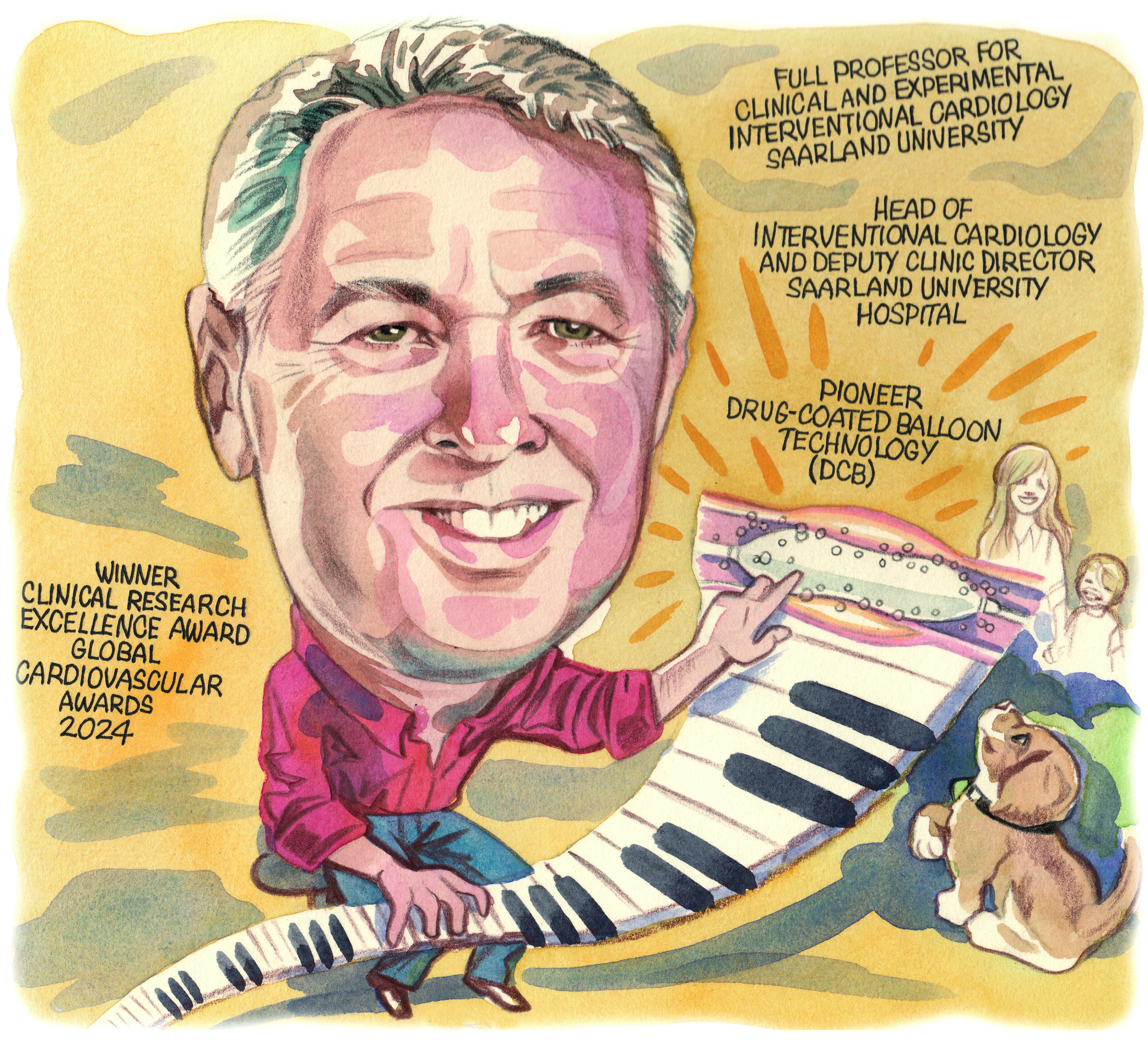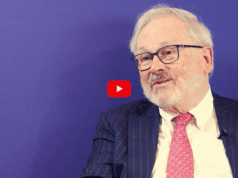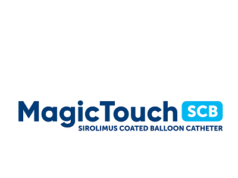 Despite a complicated early path into medicine, which was shaped by a major tragedy, Bruno Scheller (University of Saarland, Saarland, Germany) realised early on that interventional cardiology was his calling. As one of the foremost figures in research of drug-coated balloon (DCB) therapy for the treatment of coronary artery disease, he tells Cardiovascular News about how his interest in this technology came about, and what its arrival means for the future of percutaneous coronary intervention (PCI).
Despite a complicated early path into medicine, which was shaped by a major tragedy, Bruno Scheller (University of Saarland, Saarland, Germany) realised early on that interventional cardiology was his calling. As one of the foremost figures in research of drug-coated balloon (DCB) therapy for the treatment of coronary artery disease, he tells Cardiovascular News about how his interest in this technology came about, and what its arrival means for the future of percutaneous coronary intervention (PCI).
Why did you initially choose to become a doctor, and what was it that made you decide to specialise in cardiology?
I was born into a working-class family. My father, a coal miner, taught me manual skills, which I still benefit from every day in the cath lab. At secondary school, my strengths were in maths and physics, though my Abitur grade wasn’t good enough for me to fulfil the requirements for studying medicine. From a practical standpoint, it made sense to apply to study engineering or, even better, to learn a good trade. At that time, it was possible to obtain one of the desired places to study medicine in Germany by taking a test focusing on pattern recognition. This test really suited my mathematical talents, and I got a place to study medicine. However, my family had limited financial resources to support my studies, so, at the age of 19, I was faced with several challenges.
I was working part-time in an industrial plant to co-finance my education. I tried to decide which subject to study by doing internships. In the late summer of 1988, the area I was living in was shaken by the Ramstein aviation disaster. Our university hospital was one of the hospitals that had to care for the most civilian casualties. My nursing internship was in the intensive care unit, which had to bear the main burden. The professional attitude of the nursing staff made a deep impression on me and ultimately led to my decision to study medicine.
However, doubts remained. At that time, there was an oversupply of medical students in Germany, and you were only allowed to work as a junior doctor—Arzt im Praktikum—for around 700 Deutschmarks in the first year, if at all. There was no way I could afford to be unemployed or finance my life with this amount of money, meaning that in the summer of 1990 I was faced with exmatriculating from medicine and instead enrolling in a degree in electrical engineering, which would leave me with no formal way back into medical school. In my case, there was an older member of staff at the University of Saarland who apparently recognised my inner turmoil and didn’t proceed with my de-registration. I am deeply indebted to this person, as he made it possible for me to continue studying medicine.
The decision to specialise in cardiology, on the other hand, was very simple and straightforward. During an internal medicine lecture in the winter of 1990, our cardiologists proudly demonstrated how they could reopen a vessel in an ST-segment elevation myocardial infarction (STEMI) patient at night. At that time, primary percutaneous coronary intervention (PCI) was still considered experimental. It was immediately clear to me that interventional cardiology was my destiny.
Who were the biggest influences on your early career?
As a young student, I was able to join the cardiology working group of a senior physician at Saarland University Hospital. Here, I was given the opportunity to work as a student assistant and was able to learn how to plan, conduct and analyse clinical trials.
The topic of my dissertation was the influence of X-ray contrast media on the microcirculation. This work was supported by Ulrich Speck, who was then the head of the research and development (R&D) department for contrast media at Schering AG in Berlin. In addition to X-ray contrast agents, his group developed gadolinium for magnetic resonance imaging (MRI). I started my training in internal medicine and cardiology at the end of 1994 at the age of 25. Among other topics, we published data in the European Heart Journal on the influence of X-ray contrast media on outcomes after PCI.
This led to an invitation to Berlin from Schering in December 1999. Shortly before that I attended the TCT Congress in Washington, DC, where. I was impressed by preclinical data on drug-eluting stents (DESs). In Berlin, together with Prof Speck, we discussed options for modifying the properties of contrast media. One idea was to use them as carriers for antiproliferative agents.
You have been instrumental in the development of coronary DCB therapy—how did this come about?
In 2000, Prof Speck moved to the Radiology Department at Charité Hospital, Berlin, for a professorship under the direction of Bernd Hamm. We established a porcine stent restenosis model and conducted the first investigations into contrast agent-taxane formulations. We were able to show that a short-term contact of antiproliferative drugs, such as paclitaxel, with the vessel wall can lead to a dose-dependent, long-lasting biological effect.
However, it was difficult to control which dose was applied in which vascular territory. It therefore made sense to use a more lesion-specific technique such as balloon catheters, which were necessary anyway for local drug application. Surprisingly, a coating of the contrast agent iopromide and paclitaxel led to a significant inhibition of neointimal formation after experimental stent implantation. When we presented those preclinical results on DCBs in the early 2000s, the typical reaction was that, even if it worked in pigs it wouldn’t work in humans, and even if it did, nobody would need such a technology, let alone use it.
We discussed several options for a first-in-man study. At that time, it was not possible to predict from the animal data whether efficacy could be clinically proven at all or, on the contrary, whether patients could be harmed by an excessive effect. My proposal was to start with a safe indication that also represented an unmet clinical need, namely coronary in-stent restenosis (ISR), as a stent is already in place with a lot of tissue protecting it. Our first clinical study in the ISR indication was successful and paved the way for the indication of DCB for coronary ISR. Meanwhile, our Paccocath ISR trial
is seen as one of the milestones in interventional cardiology.
What role will DCBs play in the future treatment of coronary artery disease?
DESs have the best outcomes in non-complex coronary artery disease. However, we are well aware that permanent implants are associated with a device-related event rate of 2–3% per year. The more and the longer stents are implanted, the higher the event rate. Nevertheless, the treatment of ISR is actually the worst DCB indication. The real advantage of DCB therapy lies in avoiding unnecessary stent implantations and thus reducing the long-term risk for patients. The greatest advantages are in the treatment of complex lesions (long diffusely diseased, often small vessels, or bifurcations) or complex patients (diabetes mellitus, high-bleeding risk, impaired renal function, acute coronary syndrome). In the treatment of multivessel disease, especially, it is often a blended approach with a combination of DES and DCB. Current forecasts predict that around half of all coronary lesions worldwide will be treated with DCBs by the end of the decade.
How should interventionalists weigh up the choice between different DCB drug coatings?
It is important that there is corresponding clinical evidence for a specific coating. Unfortunately, if this criterion is taken into account, the DCB choice is very limited.
Personally, I usually review experimental data on tissue concentration and drug persistence over time. A long persistence of the drug is crucial for antirestenotic efficacy. Here you can see very surprising things, which in most cases are also consistent with clinical data. For example, there are big differences even for the paclitaxel-iopromide coating. A crystalline formulation with medium-sized crystals shows very good tissue persistence, while amorphous or formulations with very small crystals show a rapid decline in tissue levels. This explains, for example, the poor effectiveness in the REC-CAGEFREE 1 trial investigating a coating associated with a sharp dose decline already at 28 days. In contrast, the paclitaxel-urea coating in the same animal model shows therapeutic tissue levels still at six months. In the case of sirolimus, tissue persistence is even more critical. Here, too, we see very different data with different technologies.
Which are the studies to watch in the DCB space?
Larger trials with sirolimus DCBs are currently underway. The issue here is that larger randomised trials in de novo vessels have been started either without angiographic data (Selution, Cordis) or with negative efficacy data (MagicTouch, Concept Medical). In my view, the direct lesion-related comparison of DCB with DES is also not appropriate, as the combination of both technologies to reduce the number of permanent implants makes more sense clinically. The ongoing REVERSE study in Asia and the planned European Bifurcation Club DCB, as well as the BASKET B-ALL study will provide important data here.
What are the key unanswered questions you would like to see prioritised in future research?
For lesion preparation, the definition of quality criteria based on intravascular imaging is of great importance. Further technological improvements are possible in the field of DCB. Here, the topics of loss in the blood, transfer rate into the tissue, persistence of the drug in the vessel wall, and the reduction of distal embolisation are the goals. New drugs or combinations of drugs are also of interest.
Finally, the question remains as to what we can do if we need to scaffold the lesion despite optimal preparation. Here, too, new concepts are being developed that are based on the fixation of dissections and the temporary overcoming of elastic recoil (resorbable repair device).
We are also investigating new indications for local drug delivery beyond restenosis. Topics here include the local regression of atherosclerosis, the stabilisation of unstable plaques and aneurysms, or the neurohumoral regulation to influence cardiovascular risk factors.
DCB therapy for the treatment and prevention of restenosis was the first step into a completely new medical discipline for the prevention and treatment of cardiovascular diseases.
What is your advice to young cardiologists entering the field today?
Interventional cardiology is one of the exciting specialties in medicine. It is innovative and includes the opportunity to help patients directly. It offers many temptations, especially for young ambitious cardiologists. At the same time, this is also the greatest risk for the young cardiologist themself, but even more so for the patient.
Therefore, training in interventional cardiology requires the unconditional ability for critical self-reflection, the willingness to accept criticism from more experienced colleagues, and, above all, to understand that it is always only about the wellbeing of the patient.
Once you understand these basic principles, you will also understand why my most memorable cases were not the successes, but the cases that didn’t go so well, from which you can learn to avoid failures in the future.
Outside of medicine what are your hobbies and interests?
I used to do a lot of sports and play music, mainly keyboard instruments. Now, any remaining time has become precious, so I reserve it exclusively for my wife, my son and our puppy.










